Saturn, the ringed giant of our solar system, has fascinated astronomers for centuries. Among its many wonders, one of the most perplexing and mesmerizing phenomena is the massive hexagonal jet stream at its north pole. First discovered by NASA’s Voyager spacecraft in the 1980s and later studied in detail by the Cassini mission, this six-sided atmospheric pattern has baffled scientists for decades. How did it form? What keeps it stable? And why does it have such a perfect geometric shape?
In this article, we will explore the origins, structure, and possible explanations behind Saturn’s hexagonal jet stream, backed by the latest scientific research.
What Is Saturn’s Hexagonal Jet Stream?
Saturn’s hexagon is an enormous, long-lasting, and nearly symmetrical atmospheric phenomenon located at its north pole. It is not a storm itself but rather a jet stream—a powerful current of atmospheric winds—shaped into a hexagonal pattern. Scientists believe this structure plays a key role in the planet’s overall weather system.
 |
| Image Credit: NASA/JPL-Caltech/Space Science Institute |
Key Facts About Saturn’s Hexagonal Jet Stream
- Size: The hexagon spans about 29,000 kilometers (18,000 miles) across, meaning roughly 2.3 Earths could fit within it.
- Windspeed: The winds along the hexagonal edges move at speeds of about 320 km/h (200 mph)—comparable to Category 5 hurricanes on Earth. However, the winds inside the central region exhibit different behaviors due to deeper atmospheric currents.
- Depth: The structure extends deep into Saturn’s atmosphere, at least 300 kilometers (186 miles) downward, as revealed by Cassini’s infrared imaging. This suggests it is not just a surface-level feature but may be connected to deeper atmospheric processes.
- Lifespan: Unlike Earth’s storms, which last days or weeks, Saturn’s hexagonal jet stream has persisted for at least four decades since its discovery in the 1980s. Some scientists believe it could be a semi-permanent feature, existing for centuries or longer.
- Color Changes: Over time, the hexagon and the storm system within it change in color, likely due to seasonal variations in sunlight exposure. Chemical reactions involving sunlight and Saturn’s atmospheric particles may cause shifts in haze and cloud composition.
%20to%20mostly%20yellow%20(2017)%20as%20summer%20approaches.%20%20Smog%20particles%20from%20increased%20sunlight%20likely%20cause%20the%20color%20change,%20though%20the%20vortex%20center%20remai.webp)
Recent research suggests that wave motions and deeper atmospheric currents help maintain the stability of the hexagonal shape, preventing it from dissipating like typical storms on Earth. This ongoing mystery makes Saturn’s hexagon one of the most fascinating atmospheric features in the solar system.
The Discovery of the Hexagon At Saturn's North Pole
Saturn’s hexagonal jet stream was first observed by NASA’s Voyager 1 and Voyager 2 in 1980 and 1981. However, due to the limitations of Voyager’s cameras and Saturn’s long orbital period (29.5 Earth years), scientists could not study it in detail at that time.
In 2006, NASA’s Cassini spacecraft captured high-resolution images and videos of the hexagon, revealing its intricate structure and atmospheric dynamics. Cassini’s advanced instruments, including the Visual and Infrared Mapping Spectrometer (VIMS) and the Composite Infrared Spectrometer (CIRS), provided crucial data on the depth, composition, and thermal properties of the jet stream.
The spacecraft continued monitoring the hexagonal jet stream and the storms within it until the end of its mission in 2017, offering unprecedented insights into Saturn’s polar weather systems.
Why The Saturn's Jet Stream Is Hexagonal?
The most puzzling aspect of Saturn’s jet stream is its hexagonal shape. On Earth, large storms tend to be circular due to the Coriolis effect, so why does Saturn have a six-sided pattern? Scientists have proposed several explanations:
 |
| Image Credit: NASA/JPL-Caltech/Space Science Institute |
1. A Jet Stream Interaction
One leading hypothesis is that the hexagon forms due to a powerful jet stream encircling Saturn’s north pole. Unlike circular storms, which rotate freely, Saturn’s hexagon appears to be a standing wave—a stable pattern created by interactions between winds moving at different speeds. The hexagon itself is not a storm but a persistent jet stream that traps and influences storms within it.
Laboratory experiments have demonstrated that when fluids rotate at different speeds inside a circular container, they can naturally form geometric shapes, including hexagons. The same principle may be at work on Saturn, where winds at different latitudes interact to create a stable hexagonal boundary.
2. Wave Motion and Deep Atmospheric Influences
Some scientists believe that the hexagon is the result of complex wave dynamics within Saturn’s atmosphere. Computer simulations have shown that wave motion in a rotating fluid can lead to polygonal shapes, including hexagons. These waves may be propagating through Saturn’s deep atmosphere, reinforcing the hexagonal pattern.
Additionally, temperature gradients and convection currents in Saturn’s atmosphere may play a crucial role. The deep atmospheric forces drive the jet stream, shaping and maintaining its structure. Cassini’s infrared observations confirmed that the hexagon extends hundreds of kilometers deep, suggesting that it may be linked to planetary rotation and internal energy sources.
Does J1407b (“Super Saturn”) Have a Similar Phenomenon?
J1407b, often nicknamed “Super Saturn,” is an exoplanet located about 434 light-years away in the constellation Centaurus. It is remarkable for having a massive ring system—about 200 times larger than Saturn’s rings. But does it have a hexagonal jet stream like Saturn?
Unfortunately, we don’t know yet. Since J1407b is so far away, our current telescopes can’t capture fine details of its atmosphere. However, the presence of such an enormous ring system suggests that J1407b likely has a complex and dynamic atmosphere, making the possibility of similar jet streams or storm patterns more plausible.
How Does Saturn’s Hexagonal Jet Stream Compare to Jupiter’s Great Red Spot?
While Saturn has its famous hexagon, Jupiter is home to another giant atmospheric wonder: the Great Red Spot (GRS). This storm, which has been raging for at least 350 years, is one of the largest and longest-lasting storms in the solar system.

1. Shape and Structure
- Saturn’s hexagon is a six-sided jet stream encircling the north pole.
- Jupiter’s Great Red Spot is a massive, oval-shaped anticyclone (a high-pressure storm) located south of Jupiter’s equator.
2. Stability and Longevity
- The Great Red Spot persists due to Jupiter’s deep, turbulent atmosphere, where smaller storms continuously feed energy into it.
- Saturn’s hexagonal jet stream remains stable because of a standing wave in the atmosphere, possibly influenced by deep planetary forces.
3. Wind Speeds
- Jupiter’s Great Red Spot: Wind speeds can reach up to 430 km/h (270 mph).
- Saturn’s Hexagonal Jet Stream: Wind speeds are slightly lower at 320 km/h (200 mph).
Conclusion
Saturn’s hexagonal jet stream is one of the most fascinating and enduring mysteries of planetary science. This massive, perfectly shaped feature challenges our understanding of fluid dynamics and planetary atmospheres.
By comparing it to Jupiter’s Great Red Spot and wondering if similar phenomena exist on exoplanets like J1407b, we gain a deeper appreciation for the complexity of planetary weather. Future missions and telescopes may one day reveal even more hexagonal patterns in the universe, proving that nature’s most intricate shapes are not limited to Earth.
For further reading, check out NASA’s Cassini mission archives and related research papers on planetary atmospheres.

Comments
Post a Comment